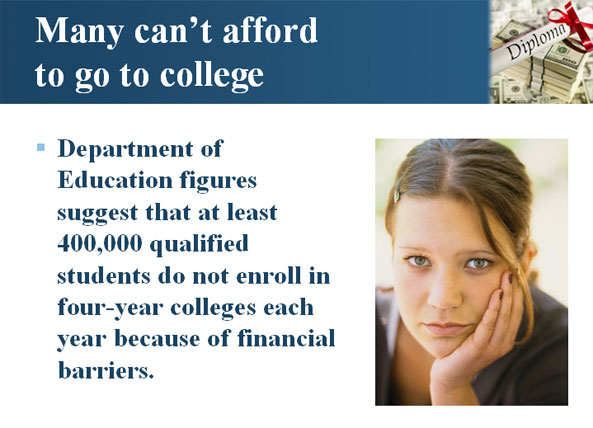College Admissions Are Still Beyond the Reach of the Economically Underprivileged
 |
|
||
 |
 |
||
 |
|
The government-funded report, "College Access for the Working Poor: Overcoming Burdens to Succeed in Higher Education," is built upon data from the U.S. Census Bureau and other federal sources.
IHEP's findings include the following:
- Heavy work and family responsibilities prevent working poor adults from attending college full-time even when they consider education their highest priority. In 2003-2004, only 37% of working poor adults enrolled full-time, while more than 50% of non-working or poor adults with less work enrolled in full-time courses.
- The financial aid that working poor adults receive is inadequate for college costs. According to statistics from the 2003-2004 academic year, working poor adults receiving financial aid had to shell out $4,000 in personal resources to continue their education over the year.
- Patterns of part-time enrollment favored by working poor adults reduce their chances of receiving financial aid. The average grant received by 54% of working poor adults in 2003-2004 was $3,000; an average grant of $3,500 was received by 67% of non-working poor adults.
- Part-time enrollment poses a barrier to completing and performing well in academic courses. It was observed that 50% of working poor adult students left college without completing their courses or receiving credentials.
- Provide tax relief for working poor students
- Offer additional institutional support for working poor students
- Focus on supporting single parents who are working poor adult students
- Provide extra institutional support for first-generation working poor adult students
www.ihep.org/Pubs/PDF/College_Access_for_the_Working_Poor_2007_Report.pdf

|
||||||||||||||||||||
+ Consolidate Your Private or Federal Student Loans Now! (Save Thousands!!)
Tell A Friend
|
The Career Resources column is presented by EmploymentCrossing, America's leading job search site dedicated to getting people jobs.
IRS Reminds Students of "Tax-Advantaged Education Expenses" By Surajit Sen Sharma On September 11th, the IRS news release "Back-to-School Tax Breaks Help Teachers Pay Classroom Costs; Aid Parents, Students With College Tuition" stressed the importance of saving receipts and maintaining expense records to take full advantage of deductions on educational expenses and credits available on federal income tax returns for 2007. + read more |


| CALCULATORS | |
| Stafford Loan Payment Calculator | |
| PLUS Loan Payment Calculator | |
| Loan Consolidation Payment Calculator | |




